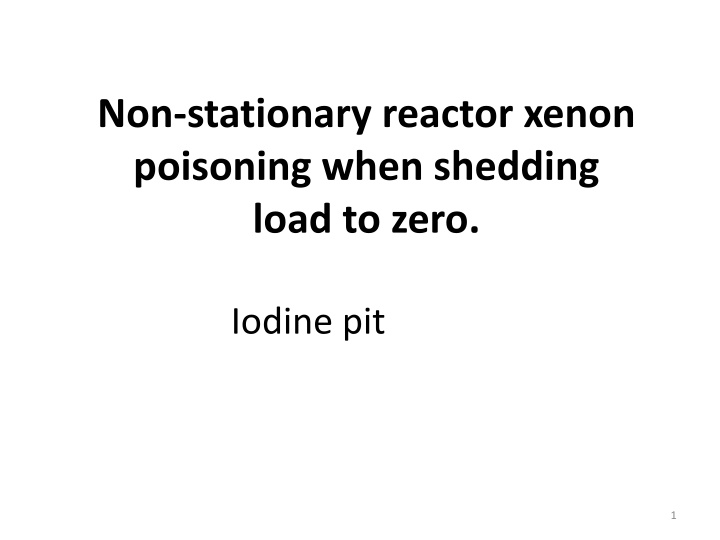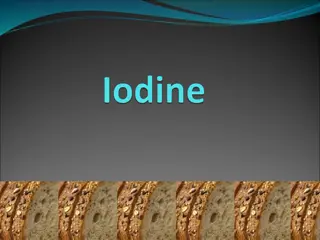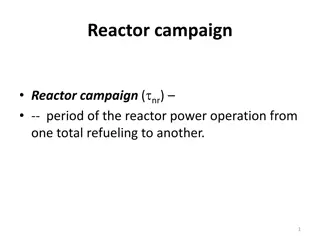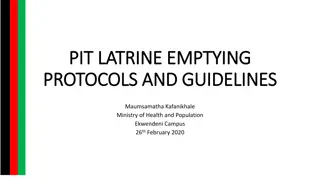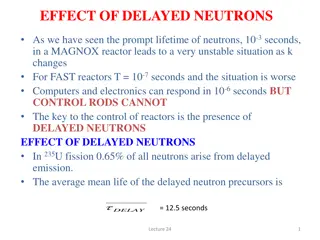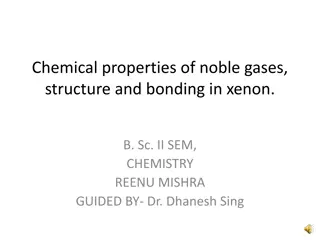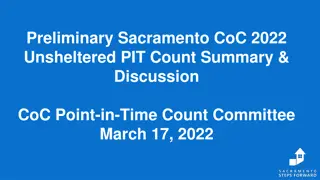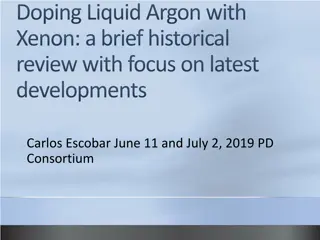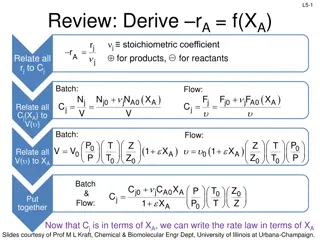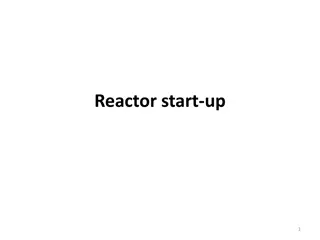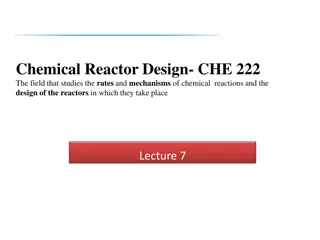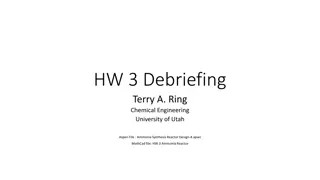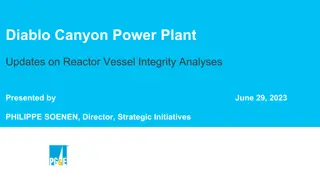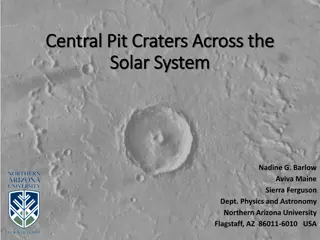Reactor Xenon Poisoning and Iodine Pit Phenomenon
When a non-stationary reactor is shut down or its load is reduced to zero, xenon poisoning occurs due to the disruption of dynamic equilibrium between the increase and decrease of 135Xe. This leads to a temporary increase in 135Xe concentration, followed by a decrease as it decays. The reactivity margin reduction post shutdown causes an undesired condition known as the iodine pit, which requires a waiting period for the 135Xe concentration to return to normal levels. The kinetics of 135Xe concentration changes are influenced by the halt in 135I formation and 135Xe burnup after reactor shutdown.
Download Presentation

Please find below an Image/Link to download the presentation.
The content on the website is provided AS IS for your information and personal use only. It may not be sold, licensed, or shared on other websites without obtaining consent from the author.If you encounter any issues during the download, it is possible that the publisher has removed the file from their server.
You are allowed to download the files provided on this website for personal or commercial use, subject to the condition that they are used lawfully. All files are the property of their respective owners.
The content on the website is provided AS IS for your information and personal use only. It may not be sold, licensed, or shared on other websites without obtaining consent from the author.
E N D
Presentation Transcript
Non-stationary reactor xenon poisoning when shedding load to zero. Iodine pit 1
Change of the reactor power leads to disruption of the dynamic equilibrium between increase and decrease of 135Xe. After shutdown or reduction of power there is a temporary increase of 135Xe concentration due to reduced burnup rate (due to the decrease of the neutron flux) and increase of the accumulation rate (due to excessive decay of135I). 2
135Xe concentration after the reactor shutdown increases (as (T1//2)Xe= 9.2 hours > (T1/ 2)I= 6.7 hours) until 135Xe decay starts to affect, as a result of which 135Xe concentration reduces to zero or until a new stationary value. 3
Effect of reducing the reactivity margin after shutdown or reduction of the reactor power is called iodine pit (pit is called "iodine" as 135Xe in this case is formed only as a product of iodine decay ). 4
When operating the reactors, iodine pit is highly undesirable because it is necessary to wait about 20 30 hours until 135Xe concentration returns to that which was before the reactor shutdown or to have a large reactivity margin in a normally operating reactor. This margin is used for rising a reactor located in the iodine pit to power, which is economically unprofitable and structurally difficult. 5
Consider the kinetics of 135Xe concentration changes at the instant reactor shutdown. From equations it follows that after reactor shutdown, 135I formation as well as 135 Xe burnup, stops completely. 135Xe concentration changes only due to radioactive decay of iodine and xenon accumulated in the nuclear fuel. 6
the picture changes iodine-135 and xenon-135 concentrations after reactor shutdown N(t) oNJ(t)=NJ oexp(- J t) NJ NXe(t) NXe t 0 t* .19.6. . o 7
changes iodine-135 and xenon-135 concentrations after reactor shutdown 8
Non-stationary poisoning by 135 after reactor shutdown Approximate nature of dependence Xe(t) for the reactor at its shutdown at the various capacities, when at the time of reduction of capacity equilibrium concentrations of 135I and 135Xe were established. 9
Time when 135Xe concentration reaches a maximum value and, accordingly, the loss of reactivity by poisoning is maximum, is called maximum time of iodine pit (ti.p.max) and loss of reactivity i.p.per time ti.p.maxis called iodine pit depth. 10
Forced reactor shutdown - a reactor state in which its start-up is impossible due to the lack of operational reactivity margin to compensate for the poisoning effect. 11
The most important characteristic of the said reactor state is forced shutdown time tf.s., i.e. time in which the loss of reactivity due to poisoning exceeds disposable reactivity margin in the absolute value. 12
Nuclear fuel conversion, conversion ratio Nuclear fuel conversion - the process of formation of secondary fissile nuclides in the nuclear reactor. 13
In the reactors operating by uranium, in addition to burnup of fissile nuclide 235U, nuclei of new fissile nuclide 239Pu at radiative capture of neutrons by 238U nuclei (reaction (n, )) are formed. Similarly, in a nuclear reactor, containing thorium 232Th in the core , a new fissile nuclide 233U is formed. 14
Consequently, there are cycles of nuclear fuel conversion cycle based on two types of nuclear reactions: uranium and plutonium cycle, thorium and uranium cycle: 92238U + n 92238U 93239Np 94239Pu; 23,5 2,3 91233Pa 90232Th + n 90233Th 92233U. 23,2 27,4 15
Nuclear fuel, containing 235U as a fissile component, is called primary. Nuclear fuel, containing 239Pu or 233U as fissile component, is called secondary. 16
The intensity of the nuclear fuel conversion process in the reactor is characterized by a conversion ratio Cratio, which equals the ratio of the amount of formed secondary fuel nuclei Nsecfor a certain period of time to the number of burnup nuclei Nburnup, for the same period of time: Cratio= Nsec/ Nburnup= ( burnup/ sec)( msec/mburnup) where: sec, burnup, msec, mburnup respectively, mass numbers and masses of the secondary and burnup fuel ; Nburnup considers burnup of the secondary fuel. 17
To characterize the conversion process, at a given time (at a given burnup fraction) differential conversion ratio is introduced, which is equal to the ratio of the formation rate of the secondary fuel nulei to the nuclei burnup rate Cratio,dif= (dNsec/dt )/(dNburnup/dt ) = dNsec/dNburnup dNsec/dt dNburnup/ dt, 18
reactivity margin The nuclear power reactor is designed to operate at rated power for a fairly long time, called the reactor core campaign. This means: throughout the campaign the reactor must remain critical. Try to imagine how the first critical state of the reactor is created: the active zone of the reactor is gradually filled with fuel assemblies until a self-sustaining fission chain reaction begins in it. In this case, it is said that the first critical mass was collected in the core.
For prolonged operation of the reactor, it is necessary to load fuel into its active zone in excess of its critical amount. But you can not do it just like that, it's dangerous: once you load some supercritical amount of fuel into the core, the reactivity will be reported to the reactor. If the reactivity value increases to ee ~ 0.0064, the reactor becomes uncontrollable.
Therefore, the supercritical amount of fuel must be loaded into the reactor with simultaneous loading of compensating absorbers into the active zone. They serve toto compensate for the emerging positive reactivity when loading into the active zone of the fuel in excess of the critical amount. It does not matter what this compensating absorber will be, but the process of loading supercritical amounts of fuel into the core should always be accompanied by synchronous introduction into the active zone of the corresponding quantities of compensating absorbers.
Thus, charging the core with a supercritical amount of nuclear fuel results in a positive reactivity that is immediately suppressed by the compensating absorbers. The overall reactivity of the reactor is that value of the positive reactivity, which is created due to the loading of the supercritical amount of nuclear fuel into the core and is simultaneously neutralized by the introduction of compensating absorbers into the active zone and is intended to provide the required reactor campaign.
In other words, the total reactivity margin - is the magnitude of the positive reactivity that could be released immediately with the mental (only mental!) removal from the active zone of all compensating absorbers. The total reactivity margin of the reactor is needed to maintain the reactor in a critical condition when it operates at a constant power level throughout the campaign and to compensate for reactor reactivity losses during its operation.
The amount of the total reactivity reserve should be such that it allows the operator (or automation system) to react quickly to any rapid changes in reactivity of the reactor and to compensate them in order to maintain the critical operating conditions of the reactor at a given power level. This part of the ORM can be compensated only by mobile absorbers. A part of the total reactivity reserve compensated by some mobile absorbers in the reactor is called the operational reactivity reserve
Operational this part of the general reserve of reactivity is named, firstly, because it is at the disposal of the operator of the reactor installation (the operator is engaged in the displacement of the absorber rods in the active zone), and secondly, because these removals of absorbers can be made rather quickly (= operatively), which ensures rapid compensation of changes in reactivity of the reactor in some transient processes.
The value of the total reactivity reserve throughout the whole reactor core campaign is decreasing, but at any point in the campaign it is composed of an operational reactivity reserve and reactivity reserves compensated by fixed (burn-out) absorbers and a liquid absorber (boric acid in water contained in the core of the reactor core ): (t) = orr(t) + ba(t) + la(t)
The values of both the total and operational reactivity margin during reactor operation vary due to changes in reactivity loss in the following physical processes: burnout of nuclear fuel - the process of a continuous loss of nuclear fuel due to its absorption by neutron nuclei; burnout leads to a decrease in reactivity; slagging of nuclear fuel - the process of accumulation in a working reactor of stable and long-lived fission products involved in the unproductive absorption of neutrons and, thereby, reducing the reactivity reserve;
Reproduction of nuclear fuel - the process of formation and accumulation in a working reactor of new types of fissionable nuclei immediately included in the general cycle of neutron multiplication and, thereby, increasing the overall reserve of reactivity; burnout of burnout absorbers is the process of slow destruction of immobile absorbers initially loaded into the active zone due to their absorption of thermal neutrons, leading to the formation of weakly absorbing products in their place, so that the reactivity reserve is released; poisoning of the reactor - the process of formation in the operating reactor of short-lived fission products involved in the unproductive capture of neutrons and, thereby, reducing the reactivity reserve upon their accumulation and increasing it upon their decay.
change in the concentration of boric acid in the water of the 1 circuit - from one name it can be understood that an increase in the concentration of boric acid leads to a decrease in the reactivity reserve, and a decrease, on the contrary, to its release; temperature changes in reactivity - with negative temperature coefficients of fuel and coolant reactivity, an increase in the temperatures of these elements leads to a decrease in the reactivity reserve, and a decrease in temperatures leads to a release of the reactivity reserve.
REDUCTION OF THE REACTIVITY MARGIN WITH THE FIRE OF NUCLEAR FUEL Burnout is the process of continuous loss in a working reactor of fissile nuclides due to their absorption of neutrons. Any fissile nuclide absorbs neutrons, and a part of the absorption ends with fissions, and the remainder - with unproductive radiation capture; but in any of these cases the fissile nuclides disappear. This process of fading nuclides in a working reactor is called the burnout of nuclear fuel.
The neutron absorption is inherent in all fissile nuclides at any level of neutron energy E. For example, for nucleus-235: a5(E) = 5f(E) + c5(E), therefore, fuel burnup is always due to neutrons of any energy present in the reactor spectrum. In particular, since our conversation mainly concerns thermal reactors of nuclear power plants, all the micro- and macro- sections of the reactions mentioned in the future will be cross- sections averaged over the spectrum of thermal neutrons and will be briefly indicated, without indicating neutron energy.
The burnup rate is nothing more than the rate of the absorption reaction by 235U nuclei of thermal neutrons. Therefore, the differential equation of the burnup rate has a very simple form: 5 5 dt dN = ( ) ( ) N t t 5 a The minus sign on the right side of the equation is evidence that it is a question of reducing the concentration of fuel nuclei with time t.
The main operating mode of the power reactor is the operating mode at a constant power level: Np (t) = idem. But the reactor power Np(t) at any time t is proportional to the product of the concentration of 235U N5(t) nuclei and the average neutron flux density in the reactor (t): Np(t) = ( E f5 V )N5(t) (t) = N N5(t) (t)
for a reactor operating at a constant power level, the differential burnup equation 235U taking into account the expression takes the form: p a idem C dt N dN = = = 5 5 5 N 5 a o o N It turns out that with a constant reactor power, the burnup rate of the main fuel in the reactor (235U) in time is constant. The solution of equation with the initial condition: t = 0 N5(0) = N50 is: 5 N t N C N = = = 5 a 5 a a ( ) 1 ( o ) N t N N t N t 5 5 5 5 5 o p o o o o
At any constant level of reactor power, the decrease in the amount of the main fuel in time follows a linear law. The rate of reduction in the amount of uranium-235 during the campaign is determined only by the magnitude of the reactor power level. Np3 Np2 0 t N5(t) N5o Np1 Np2 Np1
Let's note one more circumstance: to maintain the reactor at a constant and really the same level of power throughout the campaign, it is required to increase the value of the average neutron flux density during the campaign according to a law inversely proportional to the value of the fuel core concentration that decreases with burnout: N t N 5 5 ) ( N 1 ( p p = = = o 5 ( ) 5 C N t ) 1 C N t t N o a o a o since N5(t) decreases linearly during the campaign.
Power production of the reactor The energy production of the reactor (W) is the total amount of energy produced the reactor at the given time from the beginning of the campaign of its active zone. If the reactor operates at a constant power level Npa certain time t, then it is clear that during this time it will generate W = Npt units of energy. The size of the reactor's energy output (and its increment) at nuclear power plants is measured in extra-volatile units MW h, MWdays, or GWdays (if it is a question of large energy works).
Loss of reactivity with fuel burnup. Taking into account the fact that the product value Np t = W (t), the form of the solution of the burnout equation becomes simpler and more general: That is, now the decrease in the concentration of fuel during the campaign of the active zone can be reflected on the graph not by a family of straight lines, but by one straight line: 5 a = ( ) ( ) N t N W t 5 5 o C N
The linear character of the decrease in the concentration of 235U with the energy production of the reactor. N5(W) 5 a N5o tg = N 0 W
Since the concentration of N5(t) is proportional to the thermal neutron utilization factor (t), which gives a proportional contribution to the value of the effective neutron multiplication factor in the reactor ke(t), which is practically proportional to the reactivity of the reactor , , that the magnitude of the loss of reactivity due to burnout of fuel, practically monitors the amount of decreasing fuel concentration during the campaign. Thus, the main practical conclusion is that the loss of reactivity (reserve of reactivity) with burnup of fuel during the campaign is directly proportional to the value of the reactor's energy production.
Temperature change of the core elements effects on the effective neutron multiplication factor and therefore reactivity. In pressurized water reactors, temperature changes of coolant, which is also moderator, have the greatest effect on reactivity, as well as changes of nuclear fuel temperature. 43
Multiplication factor varies with temperature, at least, for two reasons: firstly, with the change of nuclear properties associated with the formation of the neutron energy spectrum and the Doppler effect; secondly, due to the change of material density (primarily moderator and reflector), which leads to the change of the average neutron paths and their leakage from the reactor. 44
The dependence of reactivity on temperature defines dynamic properties of the reactor and effects on its stability. Therefore, knowledge of this dependence for each reactor is absolutely necessary. 45
For a quantitative estimation of the temperature effect on the neutron multiplication conditions, one uses the notions of temperature reactivity effect (TRE) and temperature reactivity coefficient (TRC). 46
Temperature reactivity effect Temperature reactivity effect ( t) is an integral characteristic of the temperature effect on reactivity and represents the change of reactivity on heating or cooling down the reactor at a given temperature range. 47
Temperature reactivity effect is measured the same as reactivity. In those cases, when we speak of the temperature reactivity effect of a specific reactor, we mean change of its reactivity on heating from 20 to the operating temperature: = ( 2) ( 1) = (keff2 keff1) / (keff1keff2) 48
Temperature reactivity coefficient ( , -1) is a differential characteristic of the temperature effect on reactivity and represents the change of reactivity on heating the reactor by1 : = d / dT = dkeff/ (keffdT) 49
From the operational point of view, it is better to divide and into two components - slowly changing in time with the change of temperature and operating mode (isothermal tand t) and fast tracking the change of the nuclear reactor power (dynamic, power Nand N): = t+ N; = t+ N. 50
